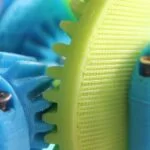How Does RC Car Steering Works (Explained)

Ever wondered how RC car steering transmitters are able to turn the car left or right? Or how your RC car is even capable of turning on its own without crashing into obstacles if you happen to let go of the transmitter controller?
Well, in this article, we will try to explain it in the simplest way possible.
So, How Does Steering Works On An RC Car
The part in your RC car that’s responsible for steering is called the servo (or in some cases, a servomechanism). It’s basically a small motor with gears and some other parts that can rotate for both sides (left or right).
As the servo rotates, it applies the force to the steering mechanism which in turn rotates the wheels based on how much force is being applied.
How Does The Servo Steers The Wheels Of Your RC Car
The servo steers the wheels of your RC car by using the steering linkage mechanism.
Here’s how it works:
The servo is connected to the steering rod by a ball joint.
The other end of the steering rod is attached to the steering link which is connected to a metal arm called the tie rod.
The tie rod will then attach to another metal arm, which in turn attaches to the steering knuckle of your RC car wheels.
When you apply a certain amount of force to the servo’s output shaft, it rotates and this rotation transfers through the steering linkage, moving one arm or another which turns the wheels of your RC car left or right.
The Steering Mechanism On An RC Car Works This Way
The steering mechanism on an RC car is just a simple mechanism allowing the car to turn left or right.
It has basically 2 arms that can be separated and pushed back together. One of these two arms is connected to the tie rod and the other arm is connected to your RC car’s suspension assembly.
When you push one of these arms, the other arm will also get pushed, turning your car left or right.
Analogue Servo And Digital Servo
Basically, there are two types of servo: analogue and digital.
An analogue servo is less powerful compared to a digital servo. Digital servos have more accurate positioning and faster response time.
The difference between analogue and digital RC car steering systems:
The distinction is in how the PWM (Pulse Width Modulation – the analogue way used to control an RC car’s servo) signal is handled. Today, PWM technology converts an analogue signal into a series of digital “steps,” which it then interprets and reduces to an analogue movement of the servo output shaft.
Analogue systems generated 50 pulses per second. Digital systems, on the other hand, receive over 300 pulses each second. This increases the speed and the precision of the servo.
Today almost all servos fitted to RC cars are digital ones.
RC Cars That Can Steer Without A Servo
Yes, there are alternative ways of steering your RC car, but the majority of RC cars use a servo.
Some steering mechanism on certain cars doesn’t use servo or linkage to steer but instead uses a gear differential connected to the wheels. And basically, it’s almost the same as the conventional steering system explained above except that there is no separate servo involved.
Here’s how it works:
There’s a motor connected to the input shaft of the gear differential. And another end of this differential is linked to your RC car’s wheels.
When you apply a certain amount of power to the input shaft, it causes one wheel spin faster than the other and so your car moves in that direction.
Another example for steering an RC car without a servo:
In this example, there’s no linkage involved. Instead, the steering is done by a separate motor that spins a metal plate on one of your RC car’s wheels.
When you apply power to this motor, the metal plate spins and thus turning your car left or right.
RC Car Steering vs. Your Conventional Car steering
Well, basically the steering mechanism in your RC car is similar to how conventional steering works, but there are differences.
Conventional steering mechanisms got more and more complex over time, whereas in RC cars it’s more simple and straightforward.
This is mainly because the steering of an RC car can’t be as complex as a real car due to shortage of space and the need to reduce the overall weight.
So instead of using rack and pinion type steering like in conventional cars, RC cars only uses the simple steering mechanism as the one explained above.
What’s Your RC Car Steering Has To Do With Your Conventional Car’s Electric Power Steering?
Basically, E-power steering uses a servo to rotate the steering mechanism instead of an actual power steering pump like in conventional cars.
Common Issues With Servos
Now that you know how servos work, here are some common problems with these steering devices.
1) Excess play in the steering mechanism will cause your car to steer sluggishly. This can be fixed by winding the clevis screw clockwise until it becomes snug.
2) If your servo is making a buzzing noise, try to tighten the screw on your servo horn.
3) If you’re unable to move your servo in both directions, it’s possible that the gears are stripped so check for any broken or stripped gears.
All the issues you can experience with RC servos
Conclusion:
Now that you understand how the steering in an RC car works, you will have a better understanding of how these devices work and be able to fix or maintain them accordingly.
Image by: Andreas Lakso, License CC BY-SA 4.0, via Wikimedia Commons





